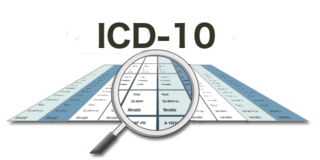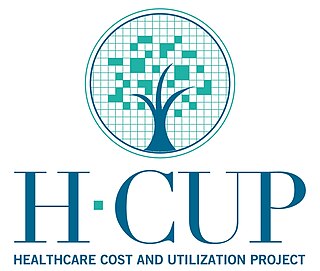Related Research Articles
The International Classification of Diseases (ICD) is a globally used diagnostic tool for epidemiology, health management and clinical purposes. The ICD is maintained by the World Health Organization (WHO), which is the directing and coordinating authority for health within the United Nations System. The ICD is originally designed as a health care classification system, providing a system of diagnostic codes for classifying diseases, including nuanced classifications of a wide variety of signs, symptoms, abnormal findings, complaints, social circumstances, and external causes of injury or disease. This system is designed to map health conditions to corresponding generic categories together with specific variations, assigning for these a designated code, up to six characters long. Thus, major categories are designed to include a set of similar diseases.
A medical classification is used to transform descriptions of medical diagnoses or procedures into standardized statistical code in a process known as clinical coding. Diagnosis classifications list diagnosis codes, which are used to track diseases and other health conditions, inclusive of chronic diseases such as diabetes mellitus and heart disease, and infectious diseases such as norovirus, the flu, and athlete's foot. Procedure classifications list procedure code, which are used to capture interventional data. These diagnosis and procedure codes are used by health care providers, government health programs, private health insurance companies, workers' compensation carriers, software developers, and others for a variety of applications in medicine, public health and medical informatics, including:
NANDA International is a professional organization of nurses interested in standardized nursing terminology, that was officially founded in 1982 and develops, researches, disseminates and refines the nomenclature, criteria, and taxonomy of nursing diagnoses. In 2002, NANDA became NANDA International in response to the broadening scope of its membership. NANDA International published Nursing Diagnosis quarterly, which became the International Journal of Nursing Terminologies and Classifications, and then later was reconceptualized as the International Journal of Nursing Knowledge, which remains in print today. The Membership Network Groups foster collaboration among NANDA-I members in countries and for languages: the German Language Group and the Dutch Language Group.
The Current Procedural Terminology (CPT) code set is a procedural code set developed by the American Medical Association (AMA). It is maintained by the CPT Editorial Panel. The CPT code set describes medical, surgical, and diagnostic services and is designed to communicate uniform information about medical services and procedures among physicians, coders, patients, accreditation organizations, and payers for administrative, financial, and analytical purposes. New editions are released each October, with CPT 2021 being in use since October 2021. It is available in both a standard edition and a professional edition.
The ICD-10 Procedure Coding System (ICD-10-PCS) is an international system of medical classification used for procedural coding. The Centers for Medicare and Medicaid Services, the agency responsible for maintaining the inpatient procedure code set in the U.S., contracted with 3M Health Information Systems in 1995 to design and then develop a procedure classification system to replace Volume 3 of ICD-9-CM. ICD-9-CM contains a procedure classification; ICD-10-CM does not. ICD-10-PCS is the result. ICD-10-PCS was initially released in 1998. It has been updated annually since that time.
In health care, diagnosis codes are used as a tool to group and identify diseases, disorders, symptoms, poisonings, adverse effects of drugs and chemicals, injuries and other reasons for patient encounters. Diagnostic coding is the translation of written descriptions of diseases, illnesses and injuries into codes from a particular classification. In medical classification, diagnosis codes are used as part of the clinical coding process alongside intervention codes. Both diagnosis and intervention codes are assigned by a health professional trained in medical classification such as a clinical coder or Health Information Manager.
The International Classification of Health Interventions (ICHI) is a system of classifying procedure codes being developed by the World Health Organization (WHO). It is currently only available as a beta release for additional coding work, and not yet ready for operational application. The last published version is denoted as beta version 2018 The multiaxial classification system has now reached a phase that the testing period for use in healthcare area is approaching during 2018. Updates on development and status of the classification are listed on WHO home page.
SNOMED CT or SNOMED Clinical Terms is a systematically organized computer-processable collection of medical terms providing codes, terms, synonyms and definitions used in clinical documentation and reporting. SNOMED CT is considered to be the most comprehensive, multilingual clinical healthcare terminology in the world. The primary purpose of SNOMED CT is to encode the meanings that are used in health information and to support the effective clinical recording of data with the aim of improving patient care. SNOMED CT provides the core general terminology for electronic health records. SNOMED CT comprehensive coverage includes: clinical findings, symptoms, diagnoses, procedures, body structures, organisms and other etiologies, substances, pharmaceuticals, devices and specimens.
Pharmacotherapy is therapy using pharmaceutical drugs, as distinguished from therapy using surgery, radiation, movement, or other modes. Among physicians, sometimes the term medical therapy refers specifically to pharmacotherapy as opposed to surgical or other therapy; for example, in oncology, medical oncology is thus distinguished from surgical oncology. Pharmacists are experts in pharmacotherapy and are responsible for ensuring the safe, appropriate, and economical use of pharmaceutical drugs. The skills required to function as a pharmacist require knowledge, training and experience in biomedical, pharmaceutical and clinical sciences. Pharmacology is the science that aims to continually improve pharmacotherapy. The pharmaceutical industry and academia use basic science, applied science, and translational science to create new pharmaceutical drugs.
The International Classification of Primary Care (ICPC) is a classification method for primary care encounters. It allows for the classification of the patient’s reason for encounter (RFE), the problems/diagnosis managed, primary or general health care interventions, and the ordering of the data of the primary care session in an episode of care structure. It was developed by the WONCA International Classification Committee (WICC), and was first published in 1987 by Oxford University Press (OUP). A revision and inclusion of criteria and definitions was published in 1998. The second revision was accepted within the World Health Organization's (WHO) Family of International Classifications.
ICPC-2 PLUS is an extended terminology classified to ICPC-2 International Classification of Primary Care, which aids data entry, retrieval and analysis. ICPC-2 PLUS takes into account the frequency distribution of problems seen in primary health care. It allows for the classification of the patient's reason for encounter (RFE), the problems/diagnosis managed, primary care interventions, and the ordering of the data of the primary care session in an episode of care structure.
MEDCIN, a system of standardized medical terminology, is a proprietary medical vocabulary and was developed by Medicomp Systems, Inc. MEDCIN is a point-of-care terminology, intended for use in Electronic Health Record (EHR) systems, and it includes over 280,000 clinical data elements encompassing symptoms, history, physical examination, tests, diagnoses and therapy. This clinical vocabulary contains over 38 years of research and development as well as the capability to cross map to leading codification systems such as SNOMED CT, CPT, ICD-9-CM/ICD-10-CM, DSM, LOINC, CDT, CVX, and the Clinical Care Classification (CCC) System for nursing and allied health.
A clinical coder—also known as clinical coding officer, diagnostic coder, medical coder, or nosologist—is a health information professional whose main duties are to analyse clinical statements and assign standard codes using a classification system. The data produced are an integral part of health information management, and are used by local and national governments, private healthcare organizations and international agencies for various purposes, including medical and health services research, epidemiological studies, health resource allocation, case mix management, public health programming, medical billing, and public education.

ICD-10 is the 10th revision of the International Statistical Classification of Diseases and Related Health Problems (ICD), a medical classification list by the World Health Organization (WHO). It contains codes for diseases, signs and symptoms, abnormal findings, complaints, social circumstances, and external causes of injury or diseases. Work on ICD-10 began in 1983, became endorsed by the Forty-third World Health Assembly in 1990, and was first used by member states in 1994. It was replaced by ICD-11 on January 1, 2022.
OPCS-4, or more formally OPCS Classification of Interventions and Procedures version 4, is the procedural classification used by clinical coders within National Health Service (NHS) hospitals of NHS England, NHS Scotland, NHS Wales and Health and Social Care in Northern Ireland. It is based on the earlier Office of Population Censuses and Surveys Classification of Surgical Operations and Procedures, and retains the OPCS abbreviation from this now defunct publication.

The Healthcare Cost and Utilization Project is a family of healthcare databases and related software tools and products from the United States that is developed through a Federal-State-Industry partnership and sponsored by the Agency for Healthcare Research and Quality (AHRQ).
The Omaha System is a standardized health care terminology consisting of an assessment component, a care plan/services component, and an evaluation component. Approximately 22,000 health care practitioners, educators, and researchers use Omaha System to improve clinical practice, structure documentation, and analyze secondary data. Omaha System users from Canada, China, The Czech Republic, Estonia, Hong Kong, Japan, Mexico, New Zealand, The Netherlands, Turkey, the United States, and Wales, have presented at Omaha System International Conferences.
The Clinical Care Classification (CCC) System is a standardized, coded nursing terminology that identifies the discrete elements of nursing practice. The CCC provides a unique framework and coding structure. Used for documenting the plan of care; following the nursing process in all health care settings.
OPS, the Operationen- und Prozedurenschlüssel is the German modification of the International Classification of Procedures in Medicine (ICPM). For German hospitals it is currently the official coding system for medical procedures. Apart from its use for clinical controlling and performance statistics it is a basis for inpatient claims processing within the German Diagnosis-related Groups (G-DRG) system. Yearly OPS releases are produced by DIMDI. Besides OPS, G-DRG also requires disease codes based on ICD-10-GM is.
The ICD-10 Clinical Modification (ICD-10-CM) is a modification of the ICD-10, authorized by the World Health Organization, used as a source for diagnosis codes in the United States of America. It replaces the earlier ICD-9-CM.
References
- ↑ "WHO / International Classification of Health Interventions (ICHI)". World Health Organization . Retrieved 2011-06-14.
- ↑ "CCI to replace ICD-9 in Canada". CODING AND BILLING SALARY. May 9, 2016.
- ↑ "CNC - NIC Overview | College of Nursing - The University of Iowa". nursing.uiowa.edu.
- ↑ ccam.sante.fr Archived October 16, 2005, at the Wayback Machine
- ↑ "Home".
- ↑ fhs.usyd.edu.au Archived June 20, 2005, at the Wayback Machine